Falchirmjäger Battalion 500 – Dragon 1/16
Adolf Hitler supposedly got the idea in September 1943, after Operation Eiche ("Oak"). Operation Eiche was launched on 12 September and included an airborne raid on Gran Sasso. The operation was planned by Kurt Student. During this raid, a group of German parachutists freed deposed Italian dictator Benito Mussolini. Otto Skorzeny took part in the raid by command of German dictator Adolf Hitler. The raid included a daring military-based assault on the Campo Imperatore Hotel at Gran Sasso and managed to rescue Mussolini, only firing a single shot.Considering that the new Waffen-SS unit of parachutists had to be employed in dangerous actions behind enemy lines, it was decided to extend enlistment to those in the SS disciplinary units which were formed from officers, non-commissioned officers and soldiers who had problems with military law. An order of the SS-FHA (the SS High Command) fixed a percentage of 50% for the unit coming from volunteers of Waffen-SS units, the rest from volunteers from the disciplinary units.
Per Massimiliano Afiero, in The Crusade against Bolshevism; European Voluntary Legions (1941–1944), Vol.1, states that many witnesses and historians placed excessive emphasis on the presence of these disciplinary personnel in the unit, mainly because of the identification number 500, assigned also to a penal unit of the Wehrmacht.
The gathering of personnel for the new unit was in Chlum in Czechoslovakia in October 1943. The first commander of the battalion was SS-Sturmbannführer Herbert Gilhofer, coming from the 21st SS-Panzergrenadier Regiment of the 10th SS-Panzer-Division Frundsberg. In November 1943, the battalion began its training in the spa Mataruška Banja, close to Kraljevo, Serbia, with the Luftwaffe Fallschirmschule number 3. The training was completed in the area around Pápa, Hungary at the beginning of 1944.
The 500th was led by Hauptsturmführer Kurt Rybka during its daring but unsuccessful parachute and glider-borne assault on Tito's headquarters outside Drvar on 25 May 1944. The raid, called Operation Rösselsprung ("Knight's Leap"), was reported in the 6 June issue of the German armed forces's daily report (Wehrmachtbericht). Two companies were dropped directly on Tito's supposed headquarters location while the other two were landed by DFS 230 glider.
The first wave of paratroopers, following a heavy bombardment by the Luftwaffe, landed in between the area of the cave, (Tito's hideout) and the town of Drvar on open ground and many were gunned down by members of the Tito Escort Battalion, a company numbering fewer than 100 soldiers. The second wave of paratroopers missed their target altogether and landed a few miles outside the town. Tito was long gone when the paratroopers captured the cave. Next to the cave's exit, there was a path leading to a railroad where Tito boarded a train that took him to safety. Tito had been forewarned and evaded capture while the numerically superior Yugoslav Partisans drove off the SS paratroopers. Over 800 of the 1,000 personnel who participated in the operation were killed or wounded.
The survivors were at first sent to Petrovac then Ljubljana, where they remained until the end of June. They were then transferred to Gotenhafen (Gdynia), West Prussia to take part in the planned occupation of the Finnish-controlled Åland Islands in the Baltic Sea, but this was cancelled. They were then sent to join III. SS-Panzerkorps at Narva, but were ordered to be flown to Kaunas, Lithuania on 9 July. There they formed a kampfguppe with I./Panzerregiment GD to relieve the trapped German forces at Vilnius. Subsequently, they often acted as 3rd Panzer Army's 'fire brigade' in its defense of the Baltic States. By 20 August 1944, they were down to a strength of 90 men,[1] but remained in combat for the next several months as the Germans were desperate for any and all combat troops to stave off the Soviet offensives.
The paras were finally relieved in late October and flown to Deutsch-Wagram, Austria where they were incorporated into the SS-Fallschirmjägerbataillon 600 after a week's rest.
The SS-Fallschirmjäger never fought in France. It is sometimes stated in histories of the French Resistance that SS paratroopers carried out a parachute assault in July 1944 against French partisan forces on the Vercors plateau in the French Alps where hundreds of partisans had created a stronghold from which they were mounting operations against the German occupiers. However, they were not Waffen-SS but Luftwaffe special forces from the secretive Kampfgeschwader 200. These para-trained commandos of II./KG 200 remain a little-known arm of Germany's World War II parachute forces and were listed on II./KG 200's ORBAT (Order of Battle) as the 3rd Staffel.
I built this figure for a good friend as he was a parachute soldier during his National Service in the late 1970's. I have always held a high regard for 'bats as I could never really figure out why anyone would jump out of a perfectly flyable aircraft.
The base was made with wood and the walls and debris from plaster of paris. The uniform was hand painted with enamels and the weathering done with oils. This figure has an eyecatching place in my friend's office.
Hope you like it.
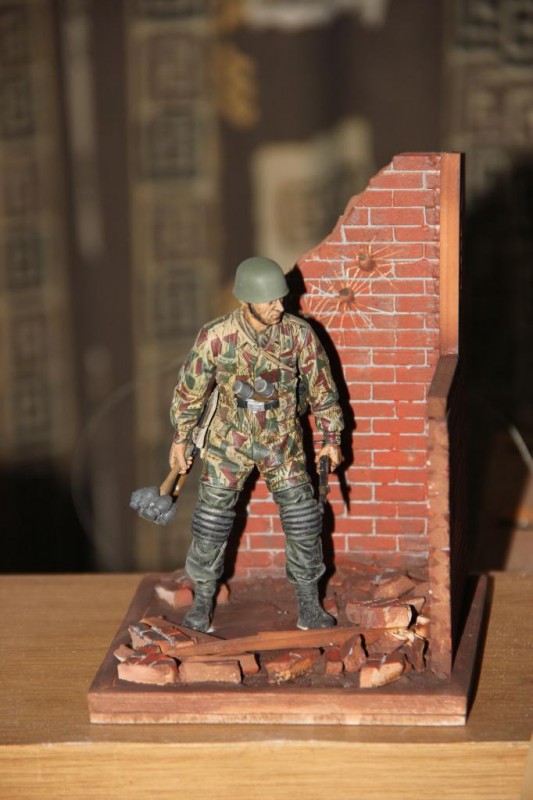
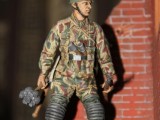


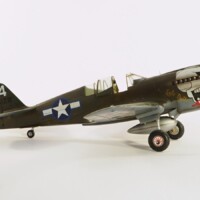
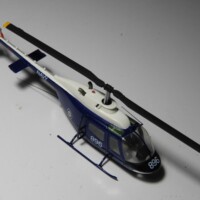
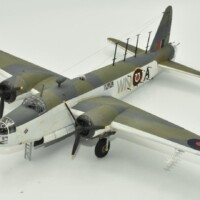
My hat's off to anyone who can paint figures realistically - I cannot. Every once in a while I may paint a pilot, but not often. Nice work, sir.
Thank you for the compliment, sir. I appreciate it.
Another outstanding job Tappie, well done Bud, it looks great. As usual.
Thanks buddy, just get your butt back out of the Congo, we have work to do.
Stunning Fallschirmjager. The camo on the uniform is impressive! Well done!
Thanks a lot.